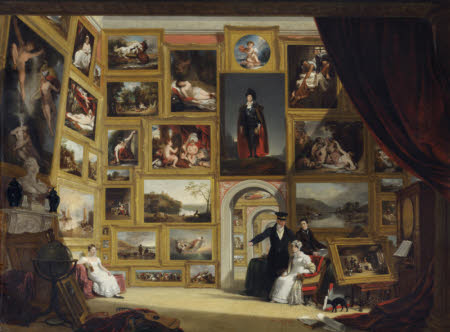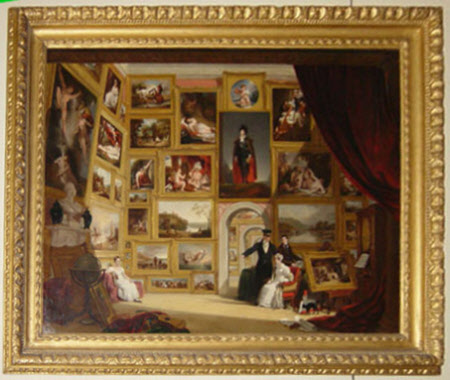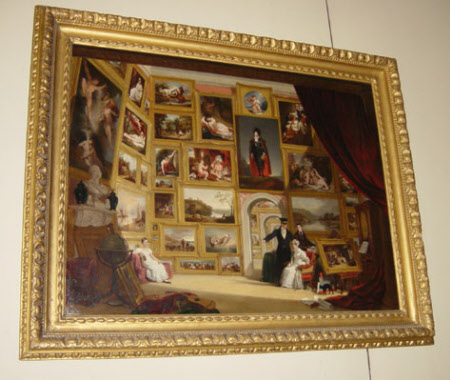A Modern Picture Gallery
William Frederick Witherington, RA (London 1785 - London 1865)
Category
Art / Oil paintings
Date
1824 (signed and dated) - 1824 (exh at RA)
Materials
Oil on canvas
Measurements
692 x 902 mm (27 ¼ x 35 ½ in)
Place of origin
England
Order this imageCollection
Wimpole, Cambridgeshire
NT 207839
Caption
This painting was exhibited at the Royal Academy in 1824 soon after the doors of the newly-founded National Gallery had opened in Pall Mall. It is an imaginary view of a gallery interior promoting Britain’s native talent of living artists. Some of the pictures were owned by Sir John Fleming Leicester, 1st Bt (1762 – 1827) of Tabley House, Cheshire and Hill Street, Mayfair who had offered to sell his collection to the nation, although he was turned down. Many can be identified, notably John Opie’s Damon and Musidora and John Hoppner’s Sleeping Nymph on the left wall which are now at Petworth (NT). Sir James Willoughby Gordon, 1st Bt is depicted with his family. His daughter and wife were both artists, the latter having been a pupil of Turner.
Summary
Oil painting on canvas, A Modern Picture Gallery by William Frederick Witherington, RA (London 1785 - London 1865), signed on the stretcher of picture at left W.F. Witherington.1824. Exhibited at the Royal Academy in 1824 and at the British Institution in Suffolk Street, a private exhibiting society with aim of encouraging native talent showing living artists alongside Old Masters in 1825. A picture gallery, with paintings hung from floor to ceiling, a bust of George IV over the mantelpiece, a young lady seated on the left, with short hair, wearing an Empire-line high-waisted dress with two rows of frills around the hemline, her left hand on her lap her right arm resting on the back of her chair holding a book in her right hand, an arch in the centre and three figures to right of arch, the woman who is seated in front of two men, is wearing an Empire-line high-waisted dress with puffed sleeves, a bonnet and a long shawl wrapped around her arms, the man standing behind her, slightly to her right, wears a high-crowned peaked cap, a long coat, waistcoat and stock he is pointing to the left with his right hand, the other younger man standing behind her chair is holding a piece of paper, there is a cat underneath her chair and another cat, with an arched back, to the right of her chair. In the left foreground is a globe on a stand, a tambourine and a lute lie on the ground, to the far right is a small organ, with sheet music on its stand. The setting is imaginary and includes paintings from several different collections. Apparently inspired by Panini's views of equally imaginary galleries, the composition carries the message, echoing both Sir George Beaumont, founder of the British Institution, and Sir John Leicester separate appeals to Lord Liverpool, PM at the time, for a national gallery of British Art, that contemporary painting could make every bit as fine a show in a picture gallery as Old Masters, and deserved support. Sir James Willoughby Gordon, 1st Bt (1772 – 1851) and his wife, Julia Isabella Levina Bennet (1772-1867), Turner's pupil, and son, Sir Henry Percy Gordon, 2nd Bt (1806 - 1876) and daughter, also an artist, Julia Emily Gordon (1810-1896) are shown. Some half of the thirty-odd visible pictures are identifiable, including (far left): Fuseli's Saturn surprised by Ithuriel (Angerstein's collection but now lost), Opie’s, Damon and Musidora (Sir John Leicester’s collection, Tabley House; now Petworth, NT 486144), Hoppner’s Sleeping Nymph and Cupid (Sir John Leicester’s collection, now Petworth, NT 486138), Gainsborough’s Harvest Wagon (now Art Gallery of Ontario, Toronto); Turner’s 1807 Sun rising through Vapour (Sir John Leicester’s collection, now National Gallery) and (facing wall, left of arch): John Ward’s Fighting Horses; William Owen’s Girl at a Spring; Henry Howard, The Pleiades disappearing(Sir John Leicester owned a larger version); Mulready’s The Carpenter's Shop; Stothard’s Canterbury Pilgrims (Tate) and (over door): Thomas Lawrence's Kemble as Hamlet (George IV, now at Tate); Reynolds's The Infant Academy (3rd Viscount Palmerston’s collection, now Kenwood) and Richard Wilson's View on the Arno (Sir John Leicester’ s collection, now Southampton City Art Gallery). Through the arch just visible are William Hilton’s Rape of Europa (Sir John Leicester’s collection; now Petworth, NT486141; Romney’s Titania, Puck and the Changeling (Leicester’s collection); (on the right): Northcote’ s Burying the Princes in the Tower and on the easel: Wilkie’s A Highland Whisky Still (Gordon’s collection in 1819).
Provenance
General Sir James Willoughby Gordon, 1st Bt (1772-1851), 1825; with Leicester Galleries, London, 1941(13), from whence bought by Captain Bambridge (1892 - 1943); bequeathed by Elsie Kipling, Mrs George Bambridge (1896 - 1976), daughter of Rudyard Kipling, to the National Trust together with Wimpole Hall, all its contents and an estate of 3,000 acres
Credit line
Wimpole Hall, The Bambridge Collection (National Trust)
Marks and inscriptions
W.F.Witherington.1824
Makers and roles
William Frederick Witherington, RA (London 1785 - London 1865), artist
References
Laing 1991 Alastair Laing, “Every picture tells a story,” Country Life, 21 March 1991: pp.110-13



